Research is fun, but I’ve met my match with bugs, so please, correct me if I’ve wrongly identified any of the bugs in this blog.
There are many Websites available with hundreds of bug images. When you get to orders and tribes and sub-orders, like beetles — sub-order Coleoptera — there are even more Websites and more images. The Internet’s a research-fanatic’s dream, but it’s really easy to get bug-brain overload.
I’m a complete bug novice, but I want to know which bugs to keep and which ones to send to another dimension. My gut instinct is to squash any bug I think’s scary looking. How fair is that? Thanks to my Texas Master Naturalist training, I shoot first (with camera) and ask questions later (research).
To make identification more difficult, adult bugs lay eggs and then the larvae go through various instar stages before becoming adults.
I thought to identify some of the seemingly common bugs in my garden in the event some of you are just as curious.
Milkweed Assassin Bugs, Zelus longipes, Order, True Bug. You might see a lot of these on your milkweed plants one morning and have a minor panic attack. Incredibly, they’re highly beneficial insects because they eat a variety of insects, including aphids, armyworms, stink bugs and houseflies.
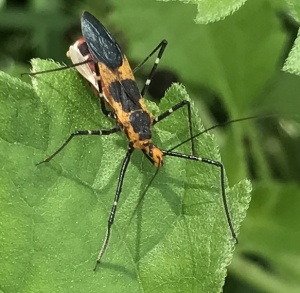
Large Milkweed Bugs, Oncopeltus fasciatus – Order, True Bug, on the other hand, lay their eggs in milkweed seed pods or in crevices between pods. Their larval food is seeds of milkweed plants.
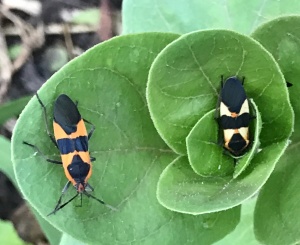
One bug really baffled me. I searched by a number of common names: scarab-, cucumber-, potato-, flower- and lady-beetle sub-families, if that is the correct terminology. Along the line I found leaf beetles and VOILA!
It’s doubly important to be able to identify bugs when you catch them doing the dirty in the garden in broad daylight because you want to know if the resultant offspring are going to be harmful or helpful.
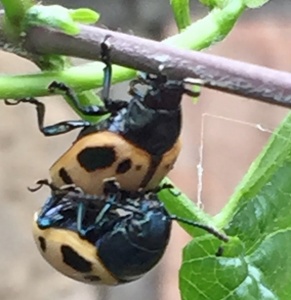
By time I’d ID’d the leaf beetles, (Family Chrysomelidae, specifically, Labidomera clivicollis), it was way too late to toss them in the resaca. This beetle, if correctly identified, lives on many species of milkweed, particularly swamp milkweed, but can be found wherever milkweed grows: meadows, grassland, roadside and wetlands. Letting these procreate probably explains why I’m missing some of my milkweed plants (zizotes).
And who doesn’t love a Lady beetle, or a Cactus Lady beetle? With or without spots, there are nearly 200 species of Lady Beetles (Family name, Coccinellidae) found in Texas. All beneficial.
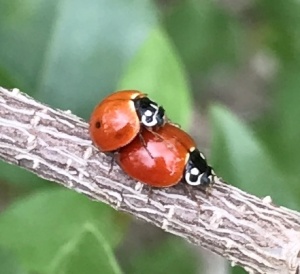
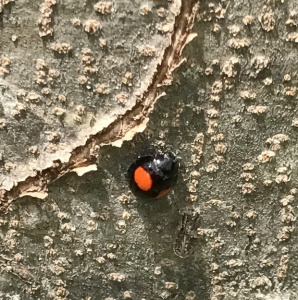
Most beetles are herbivores, eating only plants, which includes roots, stems, leaves, seeds, nectar, fruits or even the wood of the plant itself. There are numerous subcategories of beetles.
Ground beetles are nocturnal and are predators of fly maggots, grubs, slugs, snails, cutworms, cabbage maggots and other pests that live in the soil. On the down side, they also prey on earthworms and other species of beetles without discernment. It’s a crap shoot.
Soldier beetles feed on aphids, caterpillars and other insects, including harmless and beneficial species. Spined Soldier bugs eat hairless caterpillars and beetle larvae — again, both destructive and beneficial species.
Longhorn beetles vary greatly in shape, size and color. There are more than 1200 species in North America. They lay eggs in bark crevices or in soil near roots. You can use your imagination as to what the newly hatched larvae feed on. These are not our friends. They can even feed on structural wood, decorative wood pieces and furniture. Best to keep them out of the house!
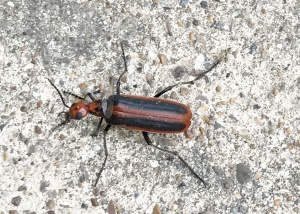
Some beetles are beautiful, literally, like this jade-colored Beautiful Mesquite Borer, Callona rimosa, found dead in Ramsey Park by Christina Mild and photographed on her glove. Its larvae feed within the bases of living Mesquite (Prosopis) and Huisache (Acacia).
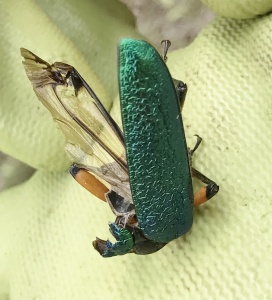
There also is a Mesquite Borer, Placostemus difficilis, which is a wood boring longhorn beetle resembling a black and yellow wasp. (Not pictured.)
Rhinoceros beetle — these are huge. Like, ping-pong-ball size huge. So huge that you really don’t want to squash one by stepping on it. And you shouldn’t want to. Adults feed on nectar, plant sap and rotting fruit. In spite of their size, the adults do not eat very much. The larvae, on the other hand, eat a great deal of rotting wood or the compost in which they live. Some species’ larvae, however, will attack healthy trees or even root vegetables.
Rhinoceros beetles are nocturnal. The female does not have horns and is generally not seen.
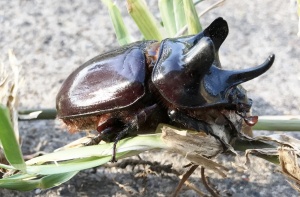
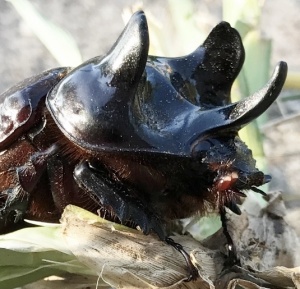
Here are some of the other bugs I’ve come across in the last couple of months – again, please, correct me if I’ve wrongly identified any of them.
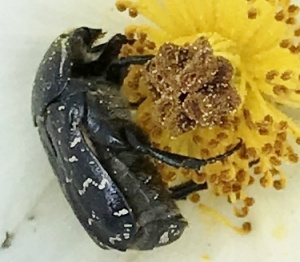
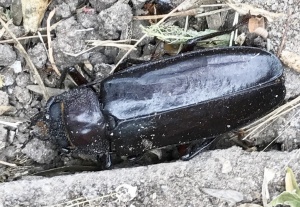
Cinch Bug (left) and possibly a Cinch bug and larvae on possum grape vine (right).
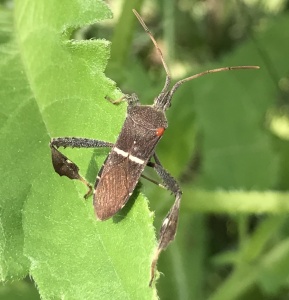
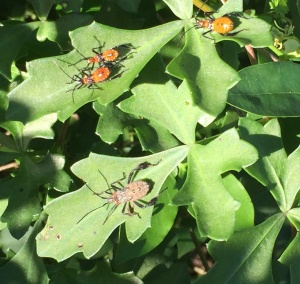
Largus Succinctus, (True Bug — suborder of Hemiptera) adults of which are thought to suck plant juices — that can’t be good.
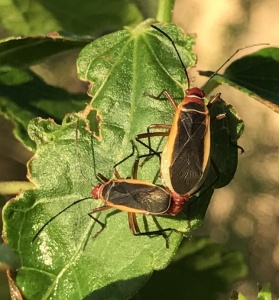
Harlequin bug on same plant as a Lady beetle. Harlequin cabbage bug will literally suck a plant dry. They prefer cabbage, cauliflower, collards, mustard but if none are available will eat tomato, potato, eggplant, okra, beans, weeds, fruit trees and field crops. Definitely a foe.
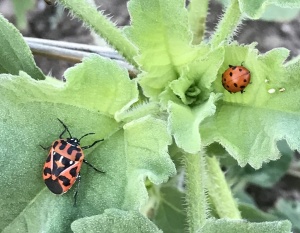
Giant Water Bug – these are pretty dastardly and offer a good reason not to jump into a resaca. It’s not a beetle nor a cockroach. The GWB is in the order Hemiptera — True Bugs — and can get to nearly four inches long. This one fortunately was found dead outside our garage door — or it may have been playing dead, as it is known to do and strike a nasty bite to a human. Although a water bug, they are attracted to lights. They eat aquatic invertebrates and vertebrates such as tadpoles, salamanders and small fish. They pierce their prey with their sharp beak and secrete enzymes that dissolve body tissue then suck the resulting liquid. — Considered an ambush hunter — Keep your distance.
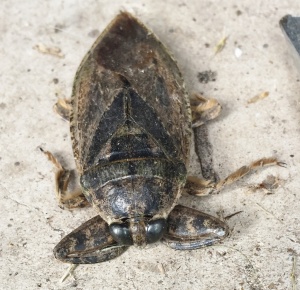
So now it’s your turn. If you can identify either of the following, I’d be grateful, please.
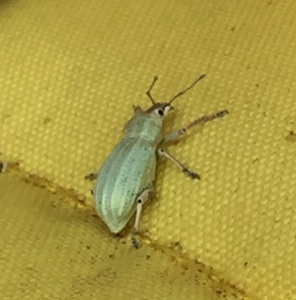
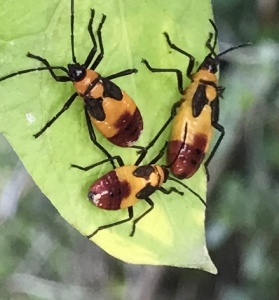
Excellent Article. Nice to know what bugs and beetles surround us all the time and we are unaware of their presence most of the time.
Thank you, Frank. You’re right about being unaware. It’s always surprising to get close to a plant and see that it’s occupied with something you’ve never seen before!
Thank goodness for Internet bug sites.
Fascinating! Thank you Anita!
Thanks, Velia — We’ll have to see who can find the most unusual bugs on our Thursday morning Ramsey work days.
They are every where. We all say “I wonder what THAT BUG is?” I think it is time to try and ID some of them. Thanks Anita
Thanks, Janet. They are indeed everywhere. If you find a really good bug ID link, share that with us, please. I search a number of ways, but sometimes start with Google. Like: red and black bug, Rio Grande Valley, Texas. Or, Bug identification guide.